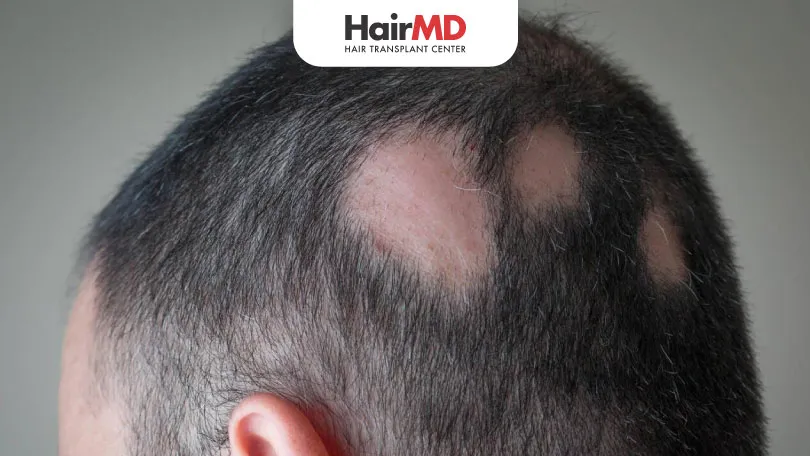28th August, 2021

Are you or someone you know struggling with alopecia areata symptoms and searching for answers? You’ve come to the right place. We frequently encounter questions about this condition from a lot of our patients. So we decided to put together a detailed blog to help you understand it better.
Alopecia areata is a significant concern for many, causing distress and impacting self-esteem. Today, we will explore what alopecia areata is, its symptoms, causes, and treatment options.
What’s covered in the article?
- What is Alopecia Areata
- What are the Symptoms of Alopecia Areata?
- Causes of Alopecia Areata?
- How is Alopecia Areata Treated?
- What Should You Do if You Have Alopecia Areata?
- Psychological Impact and Support
- Parting Thoughts
- Conclusion
What is Alopecia Areata
Alopecia areata is an autoimmune disorder where the body’s immune system mistakenly attacks its own hair follicles. This attack disrupts the normal hair growth process, leading to hair loss. You can think of it as the body’s defence mechanism turning against itself. The result is patchy hair loss on the scalp, face, and other parts of the body. This condition can affect anyone, regardless of age or gender, making it a common issue that many people face.
What are the Symptoms of Alopecia Areata?
Symptoms of alopecia areata can vary greatly from person to person. Typically, it begins with small, round, smooth patches of hair loss on the scalp. These patches can also appear on other hair-bearing areas, such as the beard, eyebrows, and eyelashes. In some cases, the hair loss is more diffuse, spreading across the entire scalp, or it may affect multiple areas of the body simultaneously.
Hair may grow back in one area and fall out in another, creating a cycle of hair loss and regrowth. The regrowth can be inconsistent, with new hair appearing in one spot and falling out in another. This unpredictability can be frustrating and emotionally challenging for those affected.
Causes of Alopecia Areata?
Understanding the exact cause of alopecia areata is still a subject of research, but we know it involves an autoimmune response. Here are some known factors that contribute to its onset:
Genetics:
If someone in your family has alopecia areata, you are more likely to develop it. A genetic predisposition plays a significant role in this condition.
Stress:
High levels of stress and anxiety can trigger or exacerbate alopecia areata. Emotional stress can influence the immune system, leading to the onset of hair loss.
Other Autoimmune Conditions:
Conditions such as pernicious anaemia, thyroid disorders, and diabetes are often associated with alopecia areata. These conditions share a common underlying mechanism involving immune system dysfunction.
Environmental Factors:
External factors like infections, toxins, and allergens can also trigger the immune response, leading to alopecia areata.
How is Alopecia Areata Treated?
Many people believe there is no treatment for alopecia areata, but that’s not true. Various treatment options can help manage symptoms and promote hair regrowth. Let’s explore these treatments in detail.
Topical Steroids
Topical steroids are often the first line of treatment. These creams or lotions are applied directly to the bald patches. They help reduce inflammation and suppress the immune system activity in the affected area, promoting hair regrowth. However, long-term use can have side effects, so it’s crucial to use them under the supervision of a dermatologist.
Injectable Treatments
Injections of corticosteroids directly into the bald patches are another effective treatment. These injections help to suppress the local immune response and stimulate hair regrowth. Typically, these injections are administered every four to six weeks, depending on the patient’s response and improvement.
Oral Medications
Oral medications, such as immunosuppressants and JAK inhibitors, can be prescribed for more severe cases. These drugs help modulate the immune system and promote hair regrowth. While effective, they come with potential side effects, so they must be taken under the guidance of a qualified dermatologist.
Minoxidil
Minoxidil is a topical medication that helps stimulate hair growth. It increases blood circulation to the hair follicles and prolongs the growth phase of the hair cycle. Consistent use of minoxidil can yield positive results, though the response rate varies among individuals.
Light Therapy
Light therapy, or phototherapy, involves using UV light to modulate the immune response and stimulate hair growth. This treatment helps reduce inflammation and suppress the immune attack on hair follicles. Multiple sessions are typically required to see significant improvement.
What Should You Do if You Have Alopecia Areata?
If you or someone you know is dealing with alopecia areata, it’s essential to consult with a qualified dermatologist. They can provide an accurate diagnosis and recommend the best treatment options based on the severity of the condition and individual patient needs.
Must Read!
Psychological Impact and Support
Alopecia areata doesn’t just affect the body; it can also take a significant psychological toll. Hair loss can impact self-esteem and confidence, leading to emotional distress. It’s crucial to seek emotional support alongside medical treatment. Family and friends play a vital role in providing encouragement and understanding.
Professional therapy and support groups can also be beneficial. Talking to others who are going through similar experiences can help alleviate feelings of isolation and provide practical coping strategies. In severe cases, such as alopecia totalis or universalis, wigs and cosmetic solutions like microblading can offer additional support.
Parting Thoughts
Alopecia areata is a challenging condition, but with the right information and support, it can be managed effectively. You must know about its symptoms, causes, and treatment options. It’s the first step towards taking control. If you or someone you know is struggling with alopecia areata, remember that treatment and support are available.
Consult with the best dermatologist to explore the best options for your situation. Emotional and psychological support is equally important in managing this condition. So do not think twice before consulting with professionals. If you want any further clarification or information, our experts are here to help. Reach out at HairMD, Pune and we will gladly help you.
Do You Know?
Nearly 250 Patients Visit HairMD
Everyday For Various Hair Concerns?
(You are one click away from flawless skin)
Meet Our Dermatologists
Conclusion
In conclusion, understanding the symptoms, causes, and treatments of alopecia areata empowers individuals to manage the condition effectively. While hair loss due to this autoimmune disorder can be unpredictable, various treatment options—ranging from topical steroids to light therapy—offer hope for regrowth. Equally important is the psychological support needed to cope with the emotional challenges it may bring. Seeking professional guidance and emotional care is essential for a balanced approach to treatment.
Further Reading
Scarring vs Non-Scarring Alopecia
Explore the differences between scarring and non-scarring alopecia. Learn about their causes, symptoms, and the most effective treatments to manage hair loss.
PRP for Female Pattern Hair Loss | PRP Hair Treatment | HairMD
Discover how Irinotecan affects hair loss, why it happens, and what you can do about it.
Alopecia Areata Treatment: Patient Testimonials | HairMD
Alopecia Areata: Patient testimonials. Know what our patients are saying about their journey of defeating Alopecia Areata with HairMD.
Is Alopecia Areata Contagious? Here’s the Truth
Discover the truth about alopecia areata. Alopecia areata is an autoimmune response and not spread by any pathogen. Learn more about the condition.
Have thoughts? Please let us know
We are committed not only to treating you, but also educating you.











